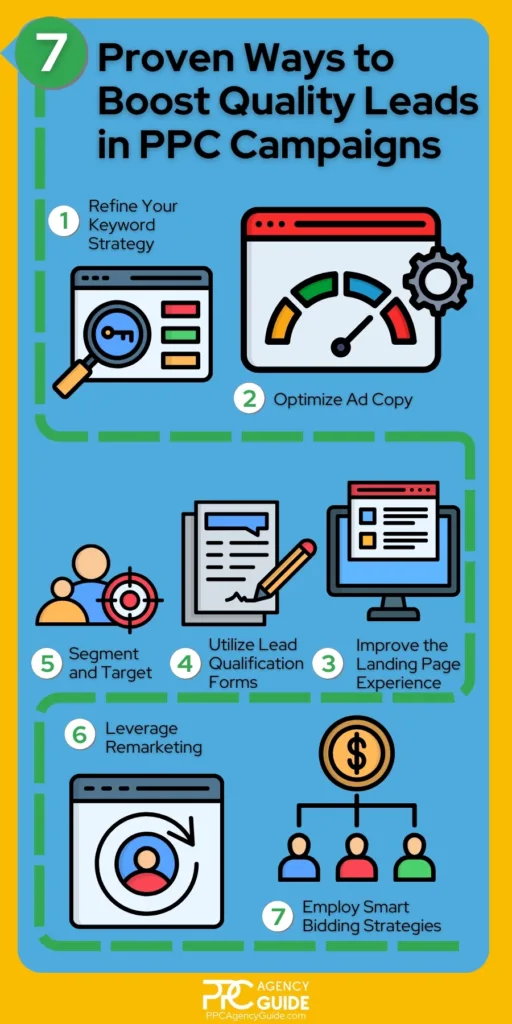
Eight out of ten new leads never become clients, SmallBizGenius reports. While this may seem grim, you actually have a high degree of control over the leads your business receives, especially if you’re leveraging pay-per-click (PPC) advertising. On this page, we’ll walk you through some tips and tricks to help you get more quality leads in PPC campaigns. The information is presented in a way that makes it easy to refine existing campaigns, though you can also use it as a checklist when you’re setting up a new campaign to help boost lead quality from the start.
How Lead Generation Works with PPC
If your primary goal is lead generation rather than immediate sales, your PPC process will likely be similar to the one outlined below.
- Keyword Selection: Your business selects keywords relevant to your products or services. If you’re running search ads, your ads may appear when a user searches for these keywords. They can also play a role in display ads.
- Ad Creation: You create ads that will show up in search results, on third-party websites, or social media platforms. These ads link to a landing page specifically designed to convert visitors into leads.
- Bidding: You’ll bid on keywords against other advertisers, with the amount you’re willing to pay for a click on your ads. The bid amount and other factors, such as ad quality, determine the ad’s placement.
- Conversion: Once visitors arrive on your landing page, you’ll try to get them to take a specific action. With lead generation, this is usually filling out a form for more information or a demo. However, some businesses use gated content, newsletter signups, and other offers to entice visitors to provide their information.
Measuring Success in Your Lead Gen Campaigns
Success in PPC lead generation is measured through various metrics, including:
- Click-Through Rate (CTR): The percentage of people who clicked on your ad after seeing it. High CTR indicates that your ads are relevant and engaging to your target audience.
- Conversion Rate: The percentage of clicks that result in a desired action (like filling out a form). This tells you how effectively your landing page converts visitors into leads.
- Quality Score: Google’s rating of the quality and relevance of your keywords and PPC ads. A higher Quality Score can lead to lower ad costs and better ad placement.
- Cost Per Lead (CPL): The total cost of generating one lead through PPC. Keeping the CPL low while maintaining or increasing lead quality is crucial for ROI.
Signs Your PPC is Generating Low-Quality Leads
Attracting low-quality leads can be a significant drain on resources and budget, especially for small businesses leveraging PPC advertising. Recognizing the signs of low-quality leads early on is crucial for adjusting strategies and ensuring your marketing efforts are effectively targeting the right audience. Below, we’ll cover some key indicators that your business might be attracting low-quality leads.
High Volume, Low Conversion

- Low Conversion Rates: If you’re experiencing a high volume of leads but few are converting into actual customers or taking meaningful actions (e.g., making a purchase, signing up for a trial), it’s a strong indicator that the leads are not of high quality.
- Poor Engagement: Leads not engaging with your follow-up communications (emails, phone calls, etc.) likely indicate a lack of genuine interest or intent.
Poor Match with Product or Service
- Irrelevant Queries: If leads are coming from keywords or queries that are not closely related to your product or service, those leads may not have a real need for what you’re offering.
- Misalignment with Target Market: Leads that fall outside your target demographic or geographic location may indicate that your ad targeting needs refinement.
Low Lead-to-Customer Conversion Rate
- High Attrition Rates: A sign of low-quality leads is when a significant number of them drop off early in the sales process or immediately after the first interaction.
- Negative Feedback: Receiving feedback from your sales team or directly from leads that indicate a misunderstanding of your product or service can signal that your messaging is attracting the wrong audience.
High Cost Relative to Value
- Increased Cost Per Acquisition (CPA): When the cost of acquiring a lead is high relative to the value that lead brings (in terms of revenue or lifetime value), it suggests that the leads are not efficiently contributing to your business goals.
- Low Return on Ad Spend (ROAS): If your PPC campaigns are not generating a satisfactory return on investment, considering both the short-term and long-term value of acquired leads, it is indicative of low lead quality.
Technical and Behavioral Signals
- High Bounce Rates on Landing Pages: This could indicate that visitors didn’t find what they were expecting from your ads, suggesting a mismatch between ad messaging and landing page content.
- Short Time on Site: If analytics show that leads spend very little time on your site or specific landing pages, it could mean they’re not finding the information or offers compelling enough to engage further.
7 Proven Strategies to Improve the Quality of Your PPC Leads
Now that we’ve covered the basics, let’s take a look at the specific strategies you can implement to improve lead quality in your PPC campaigns.
1. Refine Your Keyword Strategy
Refining your keyword strategy is the first step toward enhancing the quality of your PPC leads. It involves meticulously selecting and managing the keywords that trigger your ads to ensure they align closely with the intent of your target audience. By refining your keyword strategy, you can achieve:
- Increased Relevance: By targeting keywords aligned with user intent, you’re more likely to attract visitors genuinely interested in what you’re offering, leading to higher engagement and conversion rates.
- Cost Efficiency: Focusing on high-intent and longtail keywords can often result in lower costs per click (CPC) due to less competition, while negative keywords reduce wasted spend on irrelevant clicks.
- Better Quality Scores: Google rewards relevance. By matching your keywords closely with your ad copy and landing pages, you improve your Quality Scores, leading to better ad positions at lower costs.
Zero in on Keyword Intent
- High-Intent Keywords: These are keywords that indicate a strong intention to make a purchase or take a specific action. They often include terms like “buy,” “price,” “hire,” or “service.” By targeting high-intent keywords, you’re more likely to attract users who are further along in the buying process and ready to convert.
- Longtail Keywords: These are longer and more specific keyword phrases that users are likely to use when they are closer to the point of purchase. Longtail keywords typically have lower search volumes but higher conversion rates because they capture more precise user intent.
Utilize Negative Keywords
- Negative Keywords: Adding negative keywords to your PPC campaigns helps filter out traffic unrelated to your offerings. For example, if you sell high-end furniture, you might add “cheap” or “free” as negative keywords to prevent your ads from showing to users unlikely to convert into high-quality leads.
Continuously Optimize Keywords
- Search Term Analysis: Regularly review the search terms triggering your ads. This real-time feedback loop allows you to discover new, high-performing keywords to add to your campaigns and identify irrelevant terms to exclude as negative keywords.
- Dynamic Keyword Insertion (DKI): This advanced feature automatically updates your ad text to include one of your keywords that matches a user’s search query. DKI can help make your ads more relevant to the searcher, potentially increasing CTR and attracting more qualified leads.
2. Optimize Ad Copy
Optimizing ad copy is a critical strategy for improving lead quality in PPC campaigns. It involves crafting your ads so that they not only attract clicks but also the right clicks—those from users who are genuinely interested in your products or services and are more likely to convert. Optimizing ad copy helps in several ways:
- Improves CTR: Well-crafted ad copy that resonates with your target audience is more likely to get clicked.
- Enhances Lead Quality: By aligning your ad copy with user intent and providing clear CTAs, you attract users who are more likely to be interested in what you’re offering and ready to take action.
- Increases Conversion Rates: Effective ad copy moves users further along the conversion funnel, increasing the likelihood of converting clicks into customers.
- Lowers Cost Per Conversion: More relevant, targeted ads tend to have higher Quality Scores, which can lead to lower costs per click (CPC) and cost per conversion.
Tailor Your Message to Audience Intent
- Match Ad Copy to Keyword Intent: Your ad copy should directly address the intent behind the search query. For high-intent keywords, focus on conversion-driven language. For informational queries, emphasize the value and knowledge your product or service can provide.
- Highlight Unique Value Proposition (UVP): Clearly state what sets your product or service apart from competitors in your ad copy. Whether it’s a unique feature, a special offer, or a specific benefit, make sure it’s compelling and directly addresses your target audience’s needs.
Utilize Emotional Triggers and Clear CTAs
- Emotional Appeal: Use language that evokes emotion or creates a sense of urgency, such as “Transform your life” or “Limited offer.” This can make your ad more compelling and increase the likelihood of attracting qualified leads.
- Clear Call-to-Action (CTA): Your ad should include a clear, action-oriented CTA, such as “Buy now,” “Get a free quote,” or “Sign up today.” This guides users on what step to take next, moving them closer to conversion.
Leverage Personalization and Relevance
- Dynamic Keyword Insertion: As mentioned earlier, DKI can help personalize your ad copy by including the exact keyword that the user searched for, increasing the relevance of your ad.
- Segmentation and Targeted Messaging: Create different ad variations tailored to specific segments of your audience. This ensures that your messaging resonates with users’ varying needs and stages in the buying cycle.
Test and Refine
- A/B Testing: Regularly A/B test different versions of your ad copy to see what resonates most with your target audience. This can include variations in headlines, descriptions, and CTAs.
- Feedback Loop: Use data from your ad performance to continuously refine your messaging. Pay attention to metrics like click-through rate and conversion rate to gauge the effectiveness of your ad copy.
3. Improve the Landing Page Experience
Improving the landing page experience is pivotal for converting PPC traffic into high-quality leads. A landing page is where users arrive after clicking on your ad, and its quality significantly influences both the user’s decision to take action and the overall effectiveness of your PPC campaigns. Optimizing your landing page experience directly impacts lead quality by:
- Increasing Conversions: A typical landing page converts just under ten percent of visitors, according to HubSpot. However, a relevant, user-friendly landing page with a clear value proposition and CTA is more likely to convert visitors into leads.
- Lowering Bounce Rates: Engaging and fast-loading landing pages reduce the likelihood of users leaving without taking action.
- Improving Ad Performance: Google Ads considers the relevance and quality of your landing page when determining your ad rank and cost per click. Higher-quality landing pages can lead to better ad placements at a lower cost.
- Enhancing User Satisfaction: A positive landing page experience can leave a lasting impression, making users more likely to engage with your brand in the future.
Ensure the Page is Relevant and Cohesive
- Match with Ad Copy: The message on your landing page should directly match or complement the ad copy that led the user there. This coherence reassures users they’re in the right place and helps maintain their interest.
- Tailored Content: Customize landing page content to speak to the specific audience segment or user intent related to the ad. This might mean creating different landing pages for different ads or keywords.
Streamline the User Experience (UX)
- Clear and Concise Layout: Design your landing page with a clear hierarchy and minimal distractions to guide visitors toward your conversion goal, whether it’s filling out a form, making a purchase, or signing up for a newsletter.
- Speed Optimization: Page load time is crucial; even a one-second delay can significantly reduce conversions. Ensure your landing pages load quickly across all devices to keep potential leads from bouncing.
- Mobile Responsiveness: With an increasing number of users browsing on mobile devices, your landing page must be optimized for mobile. This includes touch-friendly navigation and ensuring all content is easily viewable without zooming or scrolling horizontally.
Enhance Credibility and Trust
- Use Testimonials and Reviews: Including social proof can significantly increase trust in your offering. Display testimonials, reviews, or logos of well-known customers to reassure potential leads.
- Professional Design: A well-designed landing page signals professionalism and credibility, encouraging users to take your call-to-action seriously.
Include a Clear CTA
- Visibility of CTA: Ensure your call-to-action is prominently displayed, easy to find, and straightforward about what the user will get by clicking on it.
- Encourage Immediate Action: Phrases like “Download Now,” “Get Your Free Quote,” or “Sign Up Today” can increase the urgency and encourage users to take action immediately.
Engage in Continuous Testing and Optimization
- A/B Testing: Regularly test different elements of your landing page, such as the headline, CTA, images, and form fields, to see what maximizes conversion rates.
- Analytics and Feedback: Use analytics tools to track how users interact with your landing page. Look at metrics like time on page, bounce rate, and conversion rate to identify areas for improvement.
4. Utilize Lead Qualification Forms
Lead qualification forms allow you to capture leads and ensure they are high quality and fit your business objectives. These forms are designed to collect specific information from potential leads through your landing pages or website, helping you to assess their interest level, needs, and how well they match your target customer profile. Implementing and optimizing lead qualification forms effectively:
- Improves Lead Quality: By gathering detailed information upfront, you ensure that leads are more likely to be a good fit for your product or service, which can increase the efficiency of your sales process.
- Enhances Lead Scoring: The data collected allows for more accurate lead scoring, helping prioritize leads that are more prepared or likely to make a purchase.
- Reduces Sales Cycle: With better-qualified leads, your sales team can focus their efforts more effectively, potentially shortening the sales cycle.
- Increases ROI: By spending resources on leads that are more likely to convert, you improve the overall ROI of your PPC campaigns.
Design the Form for Qualification Mindfully
- Targeted Questions: Include questions that help qualify a lead based on your specific criteria, such as budget, timeline, needs, or decision-making authority. This helps assess whether the lead will likely convert into a sale.
- Balancing Length and Detail: While more detailed forms can provide better qualification, they may also reduce the number of submissions. Find a balance by asking enough questions to qualify leads without deterring them from completing the form.
Optimize Form Fields
- Required vs. Optional Fields: Make key qualification questions required, but consider leaving some fields optional to reduce friction. This approach ensures you gather essential information without overwhelming the lead.
- Progressive Profiling: Use technology that allows for progressive profiling, where returning visitors are asked new questions each time, gradually building a comprehensive profile without asking too much at once.
Personalize Follow-Up Based on Responses
- Segmentation: Use the information gathered through the form to segment leads into categories based on their qualifications. This allows for more targeted and relevant follow-up communications.
- Tailored Responses: Automate response emails or contact strategies based on how the lead answered certain questions, ensuring that the follow-up aligns with the lead’s specific interests or needs.
Enhance the User Experience
- User-Friendly Design: Ensure the form is visually appealing, easy to navigate, and mobile-friendly. A positive experience can increase the likelihood of form completion.
- Value Exchange: Offer something of value in return for completing the form, such as a free e-book, webinar registration, or a discount code. This incentivizes users to provide their information.
Utilize Form Analytics and Testing
- Conversion Rate Optimization: Analyze form submission rates and drop-off points to identify areas for improvement. Experiment with different form lengths, layouts, and types of questions to see what works best.
- A/B Testing: Regularly test different versions of your lead qualification form to optimize conversions. This could involve changing the CTA, the form’s position on the page, or the incentives offered for completion.
5. Segment and Target
Segmentation and targeting are essential components of a successful PPC campaign strategy, focusing on dividing your market into distinct groups of consumers with similar needs, interests, or demographic profiles and tailoring your advertising efforts to these specific segments. This approach allows for more personalized and effective advertising, significantly improving the quality of leads generated.

Once you’ve segmented your audience, targeting allows you to direct your advertising efforts toward specific segments that are most likely to convert into high-quality leads. This precision in advertising ensures that:
- Ads are Relevant: By understanding the specific characteristics and needs of each segment, you can create ads that speak directly to those interests, increasing the likelihood of engagement and conversion.
- Resource Allocation is Optimized: Targeting enables you to concentrate your advertising budget on segments that have the highest potential to convert, improving ROI.
- Conversion Rates Improve: Personalized ads are more effective in driving actions, whether that’s filling out a form, making a purchase, or signing up for a newsletter.
- Customer Experience is Enhanced: Tailored messaging based on segmentation ensures a more relevant and personalized experience for the user, fostering positive perceptions of your brand.
Choose Your Segmentation Type
Segmentation involves breaking down your broader target market into smaller, more defined categories based on various criteria, including:
- Demographic Segmentation: Divides the market based on demographic information such as age, gender, income, occupation, and education level.
- Geographic Segmentation: Targets audiences based on their location, which can range from broad (country, state) to specific (city, zip code).
- Psychographic Segmentation: Groups consumers based on their lifestyle, interests, and activities.
- Behavioral Segmentation: Focuses on how consumers interact with your brand, including their purchase behavior, brand interactions, and product usage.
Implement Segmentation and Targeting
- Data Analysis and Insights: Use data analytics tools to gain insights into your audience’s behaviors and preferences. This can involve analyzing website traffic, social media engagement, and previous campaign performances.
- Audience Personas: Develop detailed personas for your key segments to guide your ad copy, creative, and targeting decisions.
- Platform Targeting Options: Leverage the advanced targeting options available on ad platforms like Google Ads and Facebook, which allow you to target users based on a wide array of criteria that match your segments.
- Continuous Optimization: Regularly review and adjust your segmentation and targeting strategies based on campaign performance data. This iterative process helps to refine your approach and improve lead quality over time.
6. Leverage Remarketing Campaigns
Remarketing campaigns are a powerful strategy to improve the quality of PPC leads by targeting individuals who have previously interacted with your website or mobile app but did not convert. Here’s how it helps:
- Increased Relevance: Because remarketing ads are targeted based on past behavior, they are highly relevant to each recipient. This relevance increases the likelihood that the individual will engage with the ad and take the desired action, improving the quality of the leads generated.
- Higher Conversion Rates: Individuals who have already shown interest in your website are more likely to convert than first-time visitors. By focusing on these warm leads, remarketing campaigns often see higher conversion rates than standard PPC campaigns.
- Brand Reinforcement: Remarketing keeps your brand top-of-mind for potential customers who are still in the decision-making process. Regular exposure to your brand increases recognition and trust, which can be decisive factors in the conversion process.
Set Up Remarketing
- Tracking Visitors: Remarketing involves placing cookies on your website visitors’ devices when they meet certain criteria or complete specific actions. For example, you might track visitors who viewed a product page but left without purchasing.
- Creating Audience Segments: You segment these visitors based on their behavior, such as which pages they visited, what products they viewed, or how far they got in the purchase process. This enables you to tailor your messaging to fit their level of interest and intent.
- Targeted Ads: You then create targeted ads that are displayed to these segments as they browse the web or use social media. These ads can remind them of the products they viewed, offer a special discount, or provide more information to encourage them to return to your site.
Leverage Best Practices for Remarketing
- Tailor Ads to the Audience Segment: Customize your ad copy and offers based on the specific interests and behaviors of each segment. For example, provide a special offer to users who abandoned their shopping cart.
- Frequency Capping: To avoid ad fatigue and potential negative perceptions of your brand, use frequency capping to limit how often your ads are shown to the same person.
- Privacy Considerations: Be mindful of privacy concerns and regulations, such as GDPR in Europe. Ensure you have proper consent to track and target users.
- Testing and Optimization: Continuously test different ad creatives, offers, and targeting criteria to find the most effective combinations. Use the insights gained to refine your remarketing strategies further.
7. Employ Smart Bidding Strategies
Smart bidding strategies involve leveraging artificial intelligence (AI) and machine learning algorithms provided by advertising platforms like Google Ads to optimize for conversions or conversion value in each auction in a process known as auction-time bidding. This approach automates bid adjustments based on a multitude of signals to help you achieve your specified goals, such as maximizing conversions or achieving a target ROAS. It can help improve your lead quality through:
- Optimization for Conversions: By focusing on conversions or conversion value, smart bidding directly aligns with the goal of improving lead quality. It dynamically adjusts bids to target users who are more likely to convert based on real-time data.
- Efficiency and Time-Saving: Automating the bid management process saves significant time, allowing you to focus on other aspects of campaigns, such as creativity and strategy.
- Data-Driven Decisions: Smart bidding strategies utilize a vast amount of data and machine learning, offering a level of optimization and precision that manual bidding cannot match.
- Flexibility and Control: You can set specific targets and adjust strategies based on performance, giving them control over their bidding strategies while still benefiting from AI-driven optimizations.
Implement Smart Bidding
- Define Clear Goals: Know what you’re optimizing for to select the most appropriate smart bidding strategy.
- Use Conversion Tracking: Implement robust conversion tracking to provide the data smart bidding algorithms need to optimize effectively.
- Allow for Learning Periods: Smart bidding requires a learning period to analyze data and optimize performance. Expect fluctuations in performance during this time and avoid making significant changes.
- Monitor and Refine: Continuously monitor your campaigns’ performance and adjust your targets and settings as needed to align with your lead quality and volume goals.
Get Help Attracting Quality Leads in PPC Campaigns
While the information provided here should be enough to help get most PPC campaigns back on track, implementing the strategies often requires advanced skills and time most in-house marketing teams don’t possess. Bringing on a professional can allow you to boost lead quality while maintaining strong ROI and growing your business. We’re happy to match you with a PPC agency that understands your business and audience so you can start getting the results you need quickly. To kickstart the process, request a complimentary consultation. For specialized insights into construction and real estate PPC strategies, you can explore our detailed guide on Construction and Real Estate PPC Campaigns.



















